Page 301 of 406
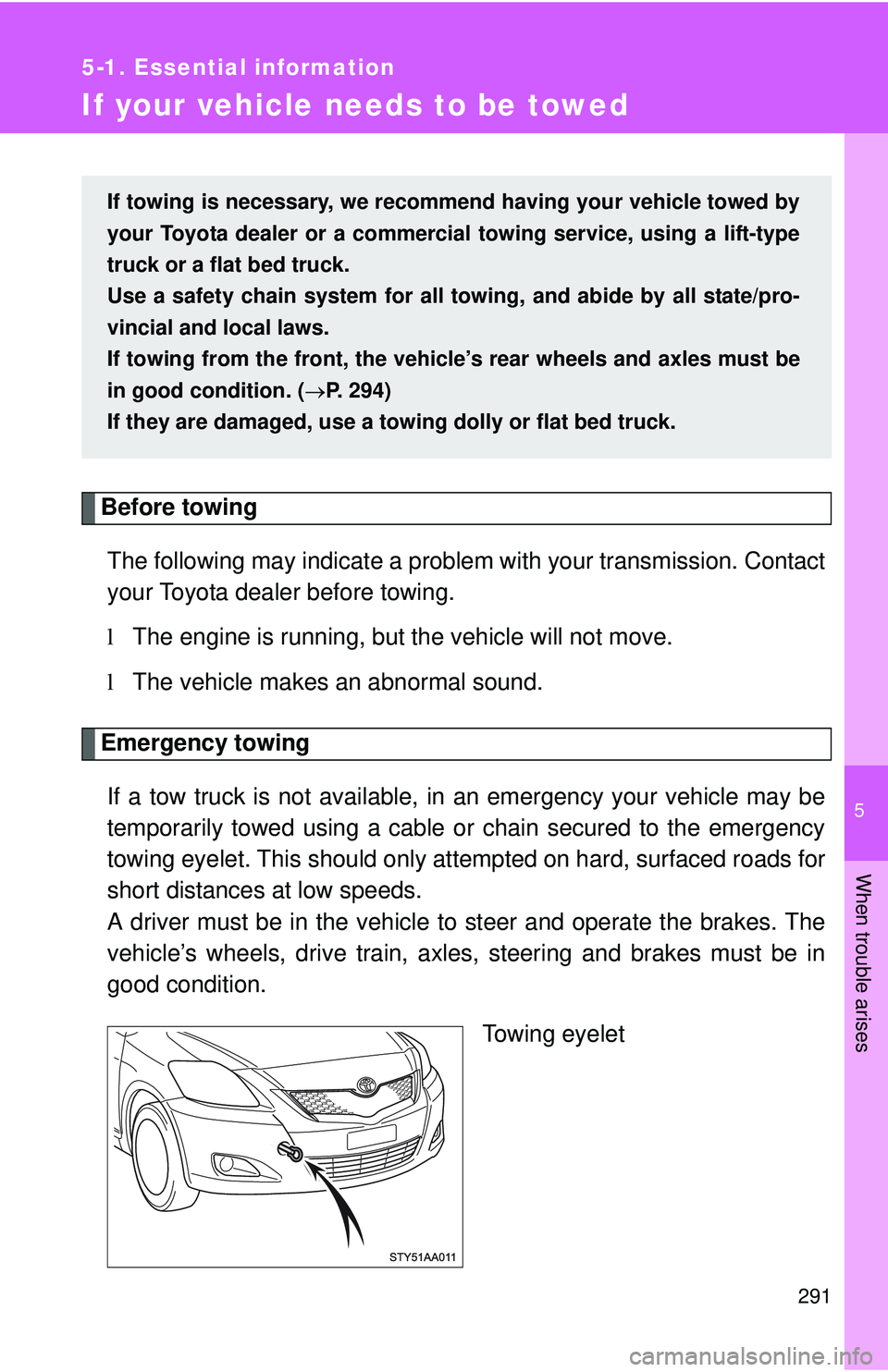
5
When trouble arises
291
5-1. Essential information
If your vehicle needs to be towed
Before towingThe following may indicate a problem with your transmission. Contact
your Toyota dealer before towing.
l The engine is running, but the vehicle will not move.
l The vehicle makes an abnormal sound.
Emergency towing
If a tow truck is not available, in an emergency your vehicle may be
temporarily towed using a cable or chain secured to the emergency
towing eyelet. This should only attempted on hard, surfaced roads for
short distances at low speeds.
A driver must be in the vehicle to steer and operate the brakes. The
vehicle’s wheels, drive train, axles, steering and brakes must be in
good condition.
Towing eyelet
If towing is necessary, we recommend having your vehicle towed by
your Toyota dealer or a commerci al towing service, using a lift-type
truck or a flat bed truck.
Use a safety chain system for all to wing, and abide by all state/pro-
vincial and local laws.
If towing from the front, the vehic le’s rear wheels and axles must be
in good condition. (→ P. 294)
If they are damaged, use a towing dolly or flat bed truck.
Page 302 of 406
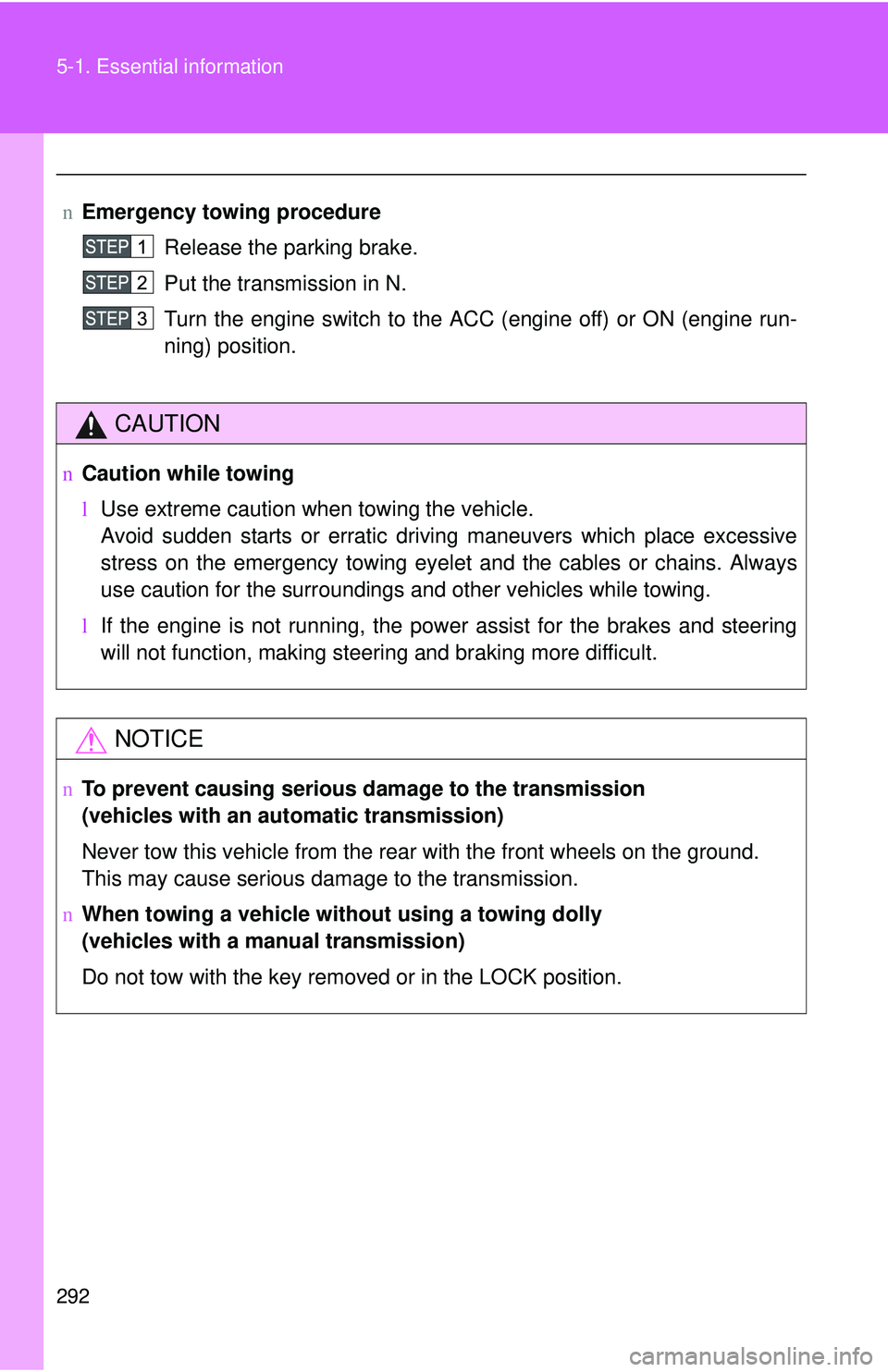
292 5-1. Essential information
nEmergency towin g procedure
Release the parking brake.
Put the transmission in N.
Turn the engine switch to the ACC (engine off) or ON (engine run-
ning) position.
CAUTION
n Caution while towing
lUse extreme caution when towing the vehicle.
Avoid sudden starts or erratic driving maneuvers which place excessive
stress on the emergency towing eyelet and the cables or chains. Always
use caution for the surroundings and other vehicles while towing.
l If the engine is not running, the power assist for the brakes and steering
will not function, making steering and braking more difficult.
NOTICE
nTo prevent causing serious dama ge to the transmission
(vehicles with an automatic transmission)
Never tow this vehicle from the rear with the front wheels on the ground.
This may cause serious damage to the transmission.
n When towing a vehicle without using a towing dolly
(vehicles with a manual transmission)
Do not tow with the key removed or in the LOCK position.
Page 304 of 406
294 5-1. Essential information
Towing with a sling-type truck
Towing with a wheel lift-type truck from the frontRelease the parking brake.
CAUTION
nInstalling towing eyelet to the vehicle
Make sure that towing eyelet is installed securely.
If not securely installed, towing eyelet may come loose during towing. This
may lead to accidents that cause serious injury or even death.
NOTICE
nTo prevent body damage
Do not tow with a sling-type truck, either from the front or rear.
Page 306 of 406
296 5-1. Essential information
Using a flat bed truckIf your Toyota is transported by a
flat bed truck, it should be tied
down at the locations shown in
the illustration.
If you use chains or cables to tie
down your vehicle, the angles
shaded in black must be 45°.
Do not overly tighten the tie
downs or the vehicle may be
damaged.
Apply the parking brake firmly.
Front
Page 307 of 406
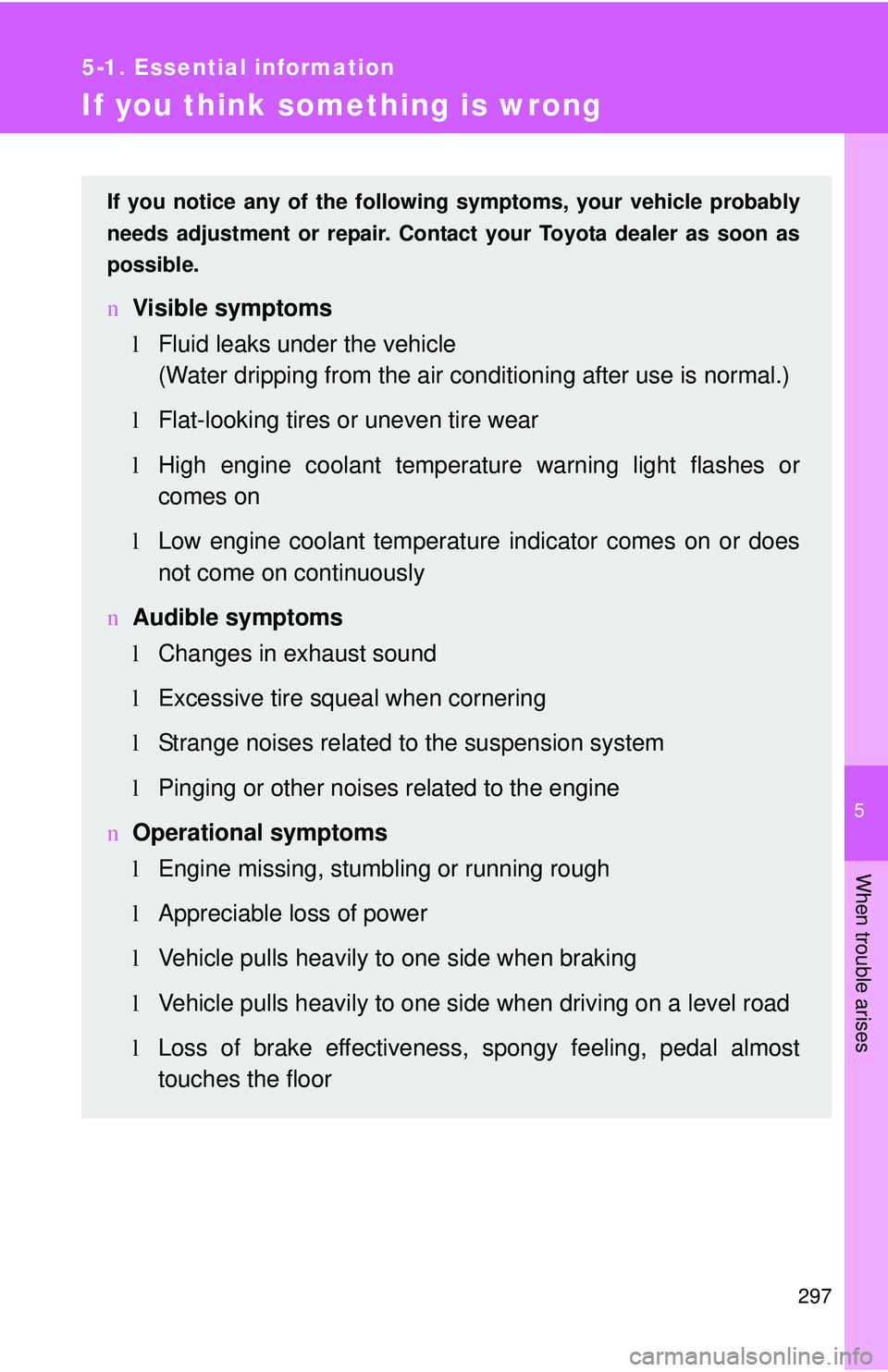
5
When trouble arises
297
5-1. Essential information
If you think something is wrong
If you notice any of the following symptoms, your vehicle probably
needs adjustment or repair. Contact your Toyota dealer as soon as
possible.
n Visible symptoms
lFluid leaks under the vehicle
(Water dripping from the air cond itioning after use is normal.)
l Flat-looking tires or uneven tire wear
l High engine coolant temperatur e warning light flashes or
comes on
l Low engine coolant temperature indicator comes on or does
not come on continuously
n Audible symptoms
lChanges in exhaust sound
l Excessive tire squeal when cornering
l Strange noises related to the suspension system
l Pinging or other noises related to the engine
n Operational symptoms
lEngine missing, stumbling or running rough
l Appreciable loss of power
l Vehicle pulls heavily to one side when braking
l Vehicle pulls heavily to one side when driving on a level road
l Loss of brake effectiveness, s pongy feeling, pedal almost
touches the floor
Page 309 of 406
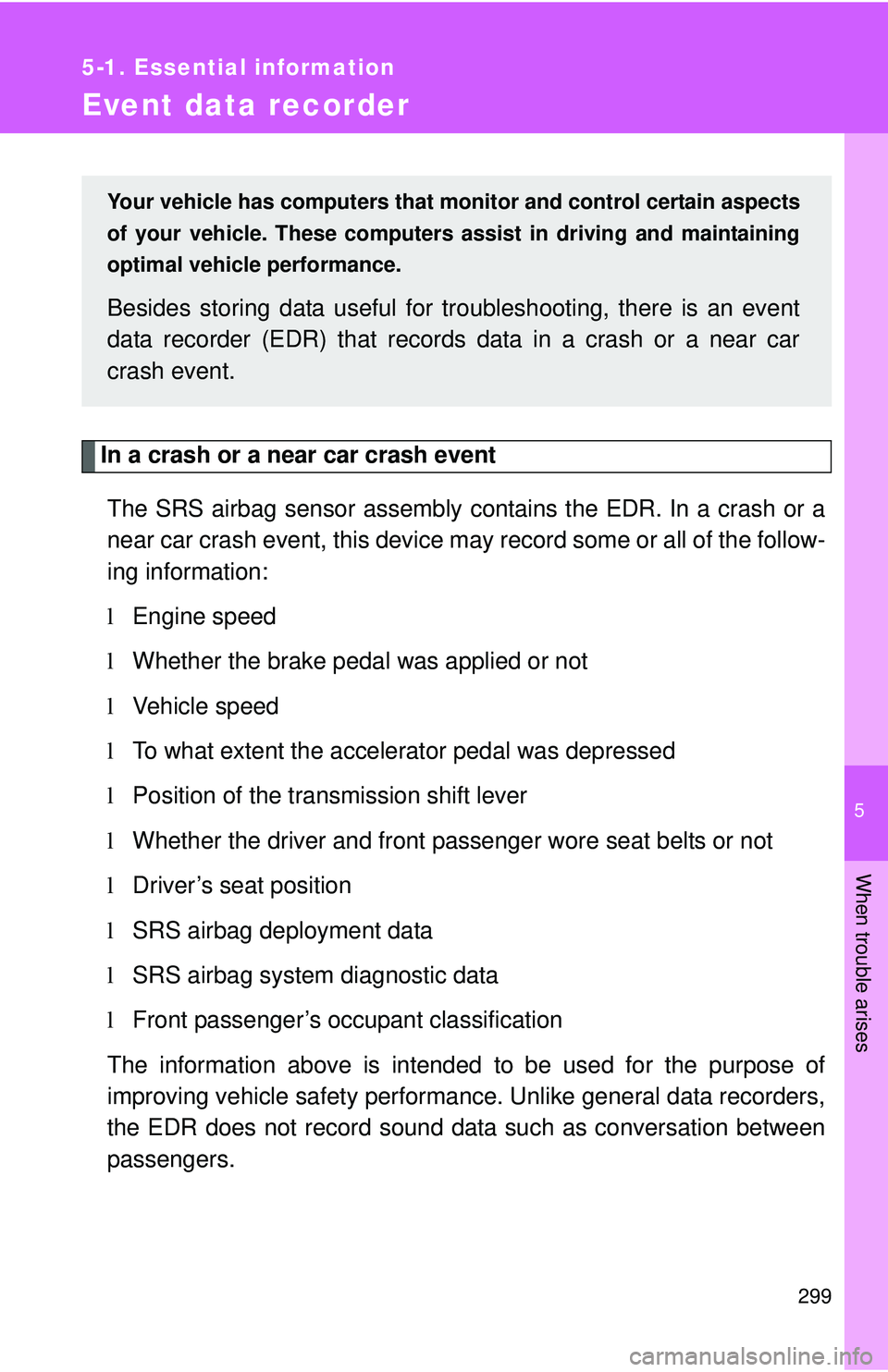
5
When trouble arises
299
5-1. Essential information
Event data recorder
In a crash or a near car crash eventThe SRS airbag sensor assembly contains the EDR. In a crash or a
near car crash event, this device may record some or all of the follow-
ing information:
l Engine speed
l Whether the brake pedal was applied or not
l Vehicle speed
l To what extent the accelerator pedal was depressed
l Position of the transmission shift lever
l Whether the driver and front passenger wore seat belts or not
l Driver’s seat position
l SRS airbag deployment data
l SRS airbag system diagnostic data
l Front passenger’s occupant classification
The information above is intended to be used for the purpose of
improving vehicle safety performance. Unlike general data recorders,
the EDR does not record sound data such as conversation between
passengers.
Your vehicle has computers that monitor and control certain aspects
of your vehicle. These computers assi st in driving and maintaining
optimal vehicle performance.
Besides storing data useful for tr oubleshooting, there is an event
data recorder (EDR) that records data in a crash or a near car
crash event.
Page 311 of 406
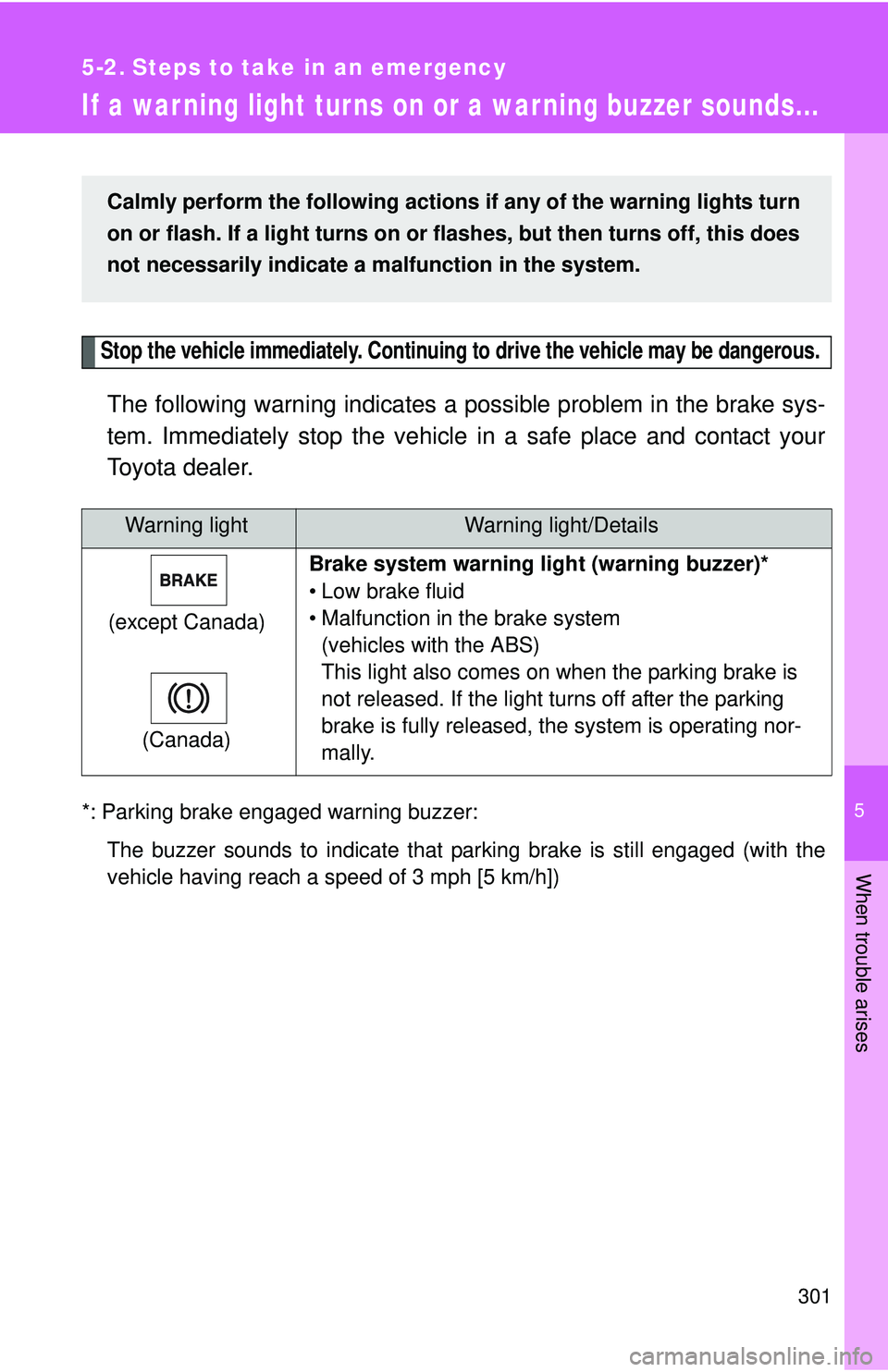
5
When trouble arises
301
5-2. Steps to take in an emergency
If a war ning light turns on or a war ning buzzer sounds...
Stop the vehicle immediately. Continuing to drive the vehicle may be dangerous.
The following warning indicates a possible problem in the brake sys-
tem. Immediately stop the vehicle in a safe place and contact your
Toyota dealer.
*: Parking brake engaged warning buzzer:
The buzzer sounds to indicate that parking brake is still engaged (with the
vehicle having reach a speed of 3 mph [5 km/h])
Warning lightWarning light/Details
(except Canada)
(Canada) Brake system warning li
ght (warning buzzer)*
• Low brake fluid
• Malfunction in the brake system (vehicles with the ABS)
This light also comes on when the parking brake is
not released. If the light turns off after the parking
brake is fully released, the system is operating nor-
mally.
Calmly perform the following actions if any of the warning lights turn
on or flash. If a light turns on or flashes, but then turns off, this does
not necessarily indicate a malfunction in the system.
Page 313 of 406
5
When trouble arises
303
5-2. Steps to take in an emergency
SRS warning light
Indicates a malfunction in:
• The SRS airbag system;
• The front passenger occupant classification system; or
• The seat belt pretensioner system.
(except Canada)
(Canada) ABS warning light (if equipped)
Indicates a malfunction in:
• The ABS; or
• The brake assist system.
Electric power steering warning light Indicates a malfunction in the EPS (Electric Power
Steering) system.
Slip indicator The indicator light comes on to indicate a malfunc-
tion in:
• The VSC; or
• The TRAC.
Warning lightWarning light/Details